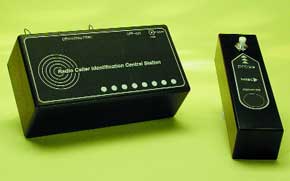Article
Radio-Linked Caller Identification System
With up to 16 caller units

This article introduces a PC-based radio-linked caller identification system. It consists of a central receiver and up to 16 caller units. The receiver is connected to a computer via the Centronics port. Each unit has a push-tomake button on it. When the button is pressed, the caller unit sends out a unique code to the soundings. The receiver intercepts the code and the computer decodes it and displays the number of the activated caller unit on the screen. The operation distance is about 75 metres in buildings and 200 metres in open fields.The system has a wide range of applications. In hotels, restaurant and shops, the caller unit can serve as a ‘Call Assistance’ button used by customers to call for assistance. It also has applications in interactive teaching environment in schools and colleges.The system utilises ‘2nd generation’ versions of FM radio transmitter and receiver modules (TX2/RX2) from Radiometrix Limited. The transmitter is a low-power device (LPD) type-approved to the Radiocommunications Authority (RA) specification MPT 1340 in the UK and Europe. This avoids the need to submit the project for final approval.
Materials
Gerber file
CAM/CAD data for the PCB referred to in this article is available as a Gerber file. Elektor GREEN and GOLD members can exclusively download these files for free as part of their membership. Gerber files allow a PCB to be produced on an appropriate device available locally, or through an online PCB manufacturing service.
Elektor recommends the Elektor PCB Service service from its business partner Eurocircuits or AISLER as the best services for its own prototypes and volume production.
The use of our Gerber files is provided under a modified Creative Commons license. Creative Commons offers authors, scientists, educators and other creatives the freedom to handle their copyright in a more free way without losing their ownership.
PCB


Discussion (0 comments)